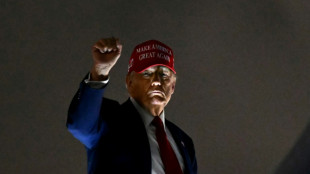

US job growth strong in March but Trump tariff impact still to come
US hiring soared past expectations in March, government data showed Friday, but analysts warn this is "old news" as the full effects of President Donald Trump's tariffs and federal cuts have yet to ripple through the country.
The world's biggest economy added 228,000 jobs last month, much more than the 130,000 economists anticipated and significantly above February's revised 117,000 figure, said the Department of Labor.
The jobless rate meanwhile edged up to 4.2 percent, from 4.1 percent in February.
Trump called these "great job numbers" in a social media post, suggesting his policies were "already working."
"The President's push to onshore jobs here in the United States is working," White House Press Secretary Karoline Leavitt said in a separate statement, pointing to job growth in areas like transportation.
Since January, the Trump administration has embarked on wide-ranging job cuts to the federal government, while the president also unleashed steep tariffs targeting allies and adversaries alike.
Economists expect it will take time for their full effects to materialize, warning of higher consumer prices and lower growth.
- 'Old news' -
"The labor market was in good shape as of last month, but it's old news considering the Trump Administration's tariff announcement and ensuing global market rout," said Nationwide chief economist Kathy Bostjancic in a note.
Trump's announcement this week of a 10 percent baseline tariff hitting US trading partners except Canada and Mexico from Saturday -- and higher rates to come on most economies -- was "larger and more complex" than expected, she said.
Mike Fratantoni, chief economist of the Mortgage Bankers Association, warned: "In light of the tariff announcements this week and the sharp drop in stock markets around the world in response, these data are likely not capturing the moment with respect to the actual strength of the economy."
Sectors that saw job gains included health care and social assistance, alongside retail trade -- "partially reflecting the return of workers from a strike," the Labor Department said.
But federal government employment declined by 4,000 in March, following the loss of 11,000 jobs in February.
Average hourly earnings grew 0.3 percent in March to $36.00, picking up slightly from February's pace.
- Rate cut caution -
"There is still substantial uncertainty of what the eventual import tariff rates will be and how long they will remain in place," said Bostjancic.
She added that "this is a very fluid situation with actions and counter actions" between Washington and trading partners.
China announced Friday steep counter tariffs on its US imports, triggering a further warning from Trump that Beijing "cannot afford" to take such action.
Trump could take further tit-for-tat measures. White House officials warned Wednesday that "if other countries retaliate," that undermines the effectiveness of Trump's order invoking emergency economic powers to impose the upcoming tariffs.
"Of course, the President is going to respond to make sure that the order is not undermined," the official told reporters.
Fratantoni expects the US central bank to stay in "data-dependent mode" and "remain cautious with respect to any rate cuts so long as inflation is above target, and the job market data continues to come in strong."
Economists are monitoring the effects of sweeping tariffs Trump imposed on major US trading partners in March, alongside the even broader action taking effect in April.
"Most economists would say this is a huge disruption," said Dan North, senior economist at Allianz Trade North America.
Uncertainty itself "is now a driving force economically," he told AFP.
Apart from adding to consumer costs in the near-term, North expects tariffs could also "put a damper on job growth."
O.Marri--al-Hayat




